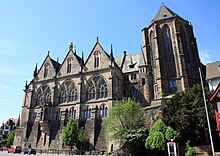Carl Schäfer
Carl Wilhelm Ernst Schäfer (born January 18, 1844 in Kassel , † May 5, 1908 in Carlsfeld , Bitterfeld district (province of Saxony) ) was a German architect and university professor .
Life
Schäfer studied engineering from 1858 to 1860, then studied architecture with Georg Gottlob Ungewitter at the higher trade school in Kassel until 1862 . From 1864 to 1866 he worked at the Paderborn Cathedral Building Office. He was the construction manager for the renovation of the cathedral and gave lessons for building craftsmen. From 1868 to 1870 he succeeded his teacher Ungewitter. From 1871 to 1878 he was a university master builder and at the same time city master builder in Marburg . From 1878 to 1885 he worked at the Prussian Ministry for Trade, Industry and Public Works in Berlin. In 1878 he completed his habilitation and was a private lecturer at the Berlin Building Academy , which was transferred to the Technical University of Charlottenburg in 1879 . In 1884 he was appointed professor and since 1885 he has been teaching medieval architecture, succeeding Johannes Otzen . From 1894 to 1907 he taught at the Technical University of Karlsruhe .
Alignment
Schäfer developed into the most important representative of the late Neo-Gothic in Germany. In the Gothic, he saw the architectural style, the elements of which are most likely derived from construction principles. For him, the basis of his work was fairness in design, material and workmanship. The Gothic style should not be imitated, but used and varied as a general constructive principle. Schäfer was fiercely attacked for his attitude by important art historians of his time ( Cornelius Gurlitt , Georg Dehio ), for whom conservation was more important than restoration, which wore him down in the long run.
With the inclusion of local building traditions and the preference for half-timbered buildings and mixed constructions, it was one of the forerunners of the Heimat style after 1900.
He advocated practical instruction in construction huts and workshops. He campaigned for craft and popular education to bring art and craft together.
buildings
Schäfer created a number of church buildings: reconstruction of the Catholic provost church St. Gertrud von Brabant in Wattenscheid 1869–1872, Catholic parish church St. Nikolai in Lippstadt 1873–1875, Protestant church in Bralitz 1889–1890, Catholic parish church St. Johannes Baptist in Bektiven 1885–1893 , Old Catholic Church in Karlsruhe 1895–1897.
The focus of his work was on secular buildings. Residential and commercial buildings ( Equitable Palace in Berlin 1887–1889), villas, manors, parsonages (Domküsterhaus in Merseburg 1886), officers' mess, restaurants, schools (Magdeburg Domgymnasium 1879–1881), the Botanical-Pharmacological Institute (1873–1875) and the auditorium building (1874–1879) of the University of Marburg and the new building of the Freiburg University Library (1895–1903).
As a monument conservator, he led the reconstruction of the Friedrichsbau of Heidelberg Castle (1890-1900), the Romanesque monastery church St. Gangolf in Münchenlohra near Nordhausen (1882-1885) and the church Saint-Pierre-le-Jeune in Strasbourg (1897-1901). He supplemented the Meissen Cathedral with a two-tower system in the neo-Gothic style (execution 1903-1908), whereby for health reasons he had to leave the practical work to his Karlsruhe students Albert Steinmetz and Joseph Schäffler. As early as 1871 he had built a fountain on the property of his lawyer Carl Grimm in Marburg.
student
While he marked the end of the Neo-Gothic as an architect, Schäfer as a university professor looked quite forward-looking: Max Berg , Hermann Muthesius , Friedrich Ostendorf , Hans Poelzig , Paul Schmitthenner , Fritz Schumacher and Franz Schneider were well-known architects from his school. He also influenced a number of other architects such as Otto Wagner , Henry van de Velde , Bruno Möhring , Hugo Hartung and Lebrecht Völki .
Fonts
- The stained glass of the Middle Ages and the Renaissance , Berlin 1881.
- Wooden architecture from 14.-18. Century , 2 vols. Berlin 1883 - 1889.
literature
- Wilhelmlesenberg : Carl Schäfer and a living architecture. In: Kunstgewerbeblatt. NF Vol. 24, H. 4, January 1913, pp. 72-78, ( Digitalisat Uni. Heidelberg ).
- Karl Caesar: Karl Schäfer In: Badische Biographien Vol. 6, Winter, Heidelberg 1927, pp. 597-604 ( digitized version ).
- Jutta Schuchard: Carl Schäfer (1844–1908). Life and work of the neo-Gothic architect. Dissertation. University of Marburg 1974. Prestel, Munich 1979, ISBN 3-7913-0373-2 .
- Angela Karasch : The Carl-Schäfer-Bau of the Freiburg University Library (1895–1903) (= writings of the Freiburg University Library in Breisgau, Vol. 9). Freiburg 1985 ( digitized version ).
- Lexicon of Art. Volume VI. Leipzig 1994, ISBN 3-363-00049-9 .
Web links
- Literature by and about Carl Schäfer in the catalog of the German National Library
- Carl Schäfer in the Saxon Biography
| personal data | |
|---|---|
| SURNAME | Shepherd, Carl |
| ALTERNATIVE NAMES | Schäfer, Carl Wilhelm Ernst (full name) |
| BRIEF DESCRIPTION | German architect and university professor |
| DATE OF BIRTH | January 18, 1844 |
| PLACE OF BIRTH | kassel |
| DATE OF DEATH | May 5, 1908 |
| Place of death | Carlsfeld , District of Bitterfeld (Province of Saxony) |


